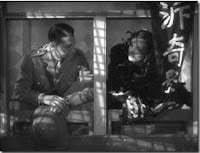When considering the Fred and Ginger phenomenon, one need only remember what Katharine Hepburn said about the duo: “She gave him sex, and he gave her class." Alone, he was far from sexy and she wasn’t close to genteel. Yet, when you put them together, all of that fell away and you saw a beautiful, sophisticated couple. All told, they made 10 films together—most of which were quite good. Their chemistry, both dancing and romantic, is undeniable and has stood the test of time. That is why today they are still regarded as THE greatest dance team ever.
Director Mark Sandrich obviously worked well with the duo, as he directed five of their films. Working from a witty screenplay penned by Allan Scott and Dwight Taylor, based on the Alexander Farago and Aladar Laszlo play The Girl Who Dared, Sandrich’s deft directorial decisions about how the film should be shot made Top Hat the duo’s biggest box office success, as well as their most critically acclaimed film. It was nominated for four Academy Awards (Best Picture, Best Interior Decoration, Best Song, and Best Dance Direction), but won none.
Astaire and Hermes Pan choreographed 
The plot revolves around a simple case of mistaken identity, which complicates a budding romance born out of an accidental meeting. Doesn’t sound too simple to you, eh? Trust me, it’s Fred and Ginger, so it’s definitely simple.
In the beginning, we meet Broadway star Jerry Travers (Astaire) as he’s hanging out in a VERY British gentlemen’s club waiting for producer Horace Hardwick (the always 
The next day we find Jerry buying flowers (from Lucille Ball nonetheless) and being rebuffed by Dale when he offers to take her to a riding club. Not deterred, he decides to pretend to be the hansom cab driver. She recognizes him by his tapping feet, but isn’t that angry. Later, as she’s riding a storm breaks out and she seeks cover. Jerry attempts to come to the rescue, but she gives him the cold shoulder. That is, until a 
Back at the hotel Dale gets a telegram from Mrs. Hardwick suggesting she look up her husband at the hotel. After much confusion, Dale begins to think that Jerry is Mr. Hardwick—oh, no you didn’t! Slap! Not given the courtesy of knowing why he’s been 
With a quick dissolve, we find ourselves looking at an interesting Art Deco set of what RKO thought Venice should look like. Evidently everything there is a glowing white color. Anyway, after arriving in Venice Dale informs Madge about her husband and the two cook up a plan to teach him a lesson. Of course, Dale 
To escape her conundrum, Dale decides to marry her designer, Alberto Beddini (Erik Rhodes). After learning that the woman he loves has married another man because she mistook him for Horace, Jerry decides he must rescue Dale before she can consummate her marriage. His rescue plan: to dance as loud as possible above the bridal suite. This angers Beddini, a master fencer, and he goes to challenge Jerry to a duel. This give Jerry the opportunity to kidnap 
Overall, the musical numbers are top notch. The standout number is, of course, “Cheek to Cheek”, but the other numbers are of a high caliber as well. Irving Berlin combined with Astaire and Pan’s choreography is pure magic.
The Art Deco sets are elegant and quite interesting to observe. In addition, the clothes (especially the evening gowns) are chic and expertly designed. When you combine the wardrobe and set design, you have one very sleek, sophisticated looking film.













































